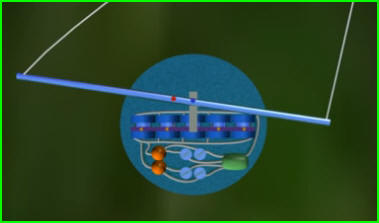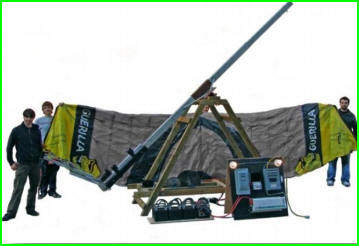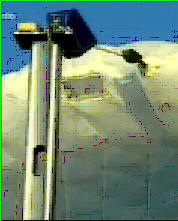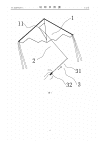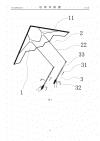|
Pole Kiting
(PoleK)
... open for
progress by all

Discuss at:
AirborneWindEnergy/conversations/messages/11548
aka "kite on a stick"
[[Off topic, but close to heart: See a John Harvey
photo for the bird kite on a stick.]]
(pole, bar, beam, stick,
control stick, fishing pole, stem, lever arm, long arm, extended arm,
towers, ) Without prejudice there are some activities that may use the
term "pole kiting" that are aside and off our present topic:
One is the otherwise interesting kiting done
near the geographic poles of earth. And the pole kiting that implies
holding a pole-mounted camera to shoot selfies while kiting. We note too
that a standing human hold kite line could be consider a "pole" while
leaving such kiting to other folders, not this one; however, human holding
and operating a stick or pole with tether from pole is for view in this
folder. Have the line set of a kite system
attached to some part of a pole, often an end of a pole or even two ends
of a pole. Then the pole is part of the resistive or reaction or anchor
set of the kite; anchor assembly may be moving vehicles or the like. The
pole might be fixed in the ground or on some other base object or handled
by a pole-wielding human or animal or robot. The pole could be operated to
move along some path. The length of line to the wing set could vary.
Purposes for pole kiting may vary widely. And special techniques allow
various kinds of dynamics and results. We invite all to send notes about
various kinds of pole kiting. Winding methods and devices may or may not
be involved. The pole may be short or long. We generally leave
control-bar kiting just in other folders. Aim to discuss
conventional control-bar kiting in topic threads that differ from the rest
of "pole" kiting. Pole kiting may be done indoors
or outdoors. PoleK spans from tiny-tot toys to expensive
professional AWES. Thanks.
Any novel inventive tech described herein by JoeF is licensed via kPower
under
CC BY NC SA. Others sharing their information may state their own IP
status. When not signed, assume JoeF until distinguishing
other author or contributor or priority person. Why PoleK?
| Miscellany | PoleK Safety | Articles
| Types of Pole Kiting | |
|
Why PoleK?
-
 Using
many poles in one carousel system KiteGen conceives of super torque at
groundgen hub of the pole spokes. Each pole would host a sub-kite
system. The global kite system consists of many pole kite units. They
leave the matter open for each pole to host a kite train of many wings.
Click for
large image of the art. Using
many poles in one carousel system KiteGen conceives of super torque at
groundgen hub of the pole spokes. Each pole would host a sub-kite
system. The global kite system consists of many pole kite units. They
leave the matter open for each pole to host a kite train of many wings.
Click for
large image of the art.
- Doug Selsam offers a pole-borne idea: "Let the pole rotate, while
[[Ed., the pole would be]] supporting a stack of rotors, and you're back
to SuperTurbineŽ" The challenge for RAD
would be getting such assembly to high altitude winds by kiting methods.
Such poles flown within tethered-wing kite systems is feasible; ever the
cost analysis would be important.
-
 LTA-lifted Sky Serpent was pole based with pole based on van. The
autorotating blades cooperated in rotating a long driveshaft fit to an
electric generator at the pole top. The balloons could be advanced
kytoon or other kite wings. The photo shows some of the blades in
partial lifting mode, some in close to zero-lift mode, and some with
slightly negative lift mode, but all blades were playing a part in
rotating the torque tube driveshaft on which the blades were mounted.
Click to get enlarge copy of the newspaper photo from the 2009 HAWP
conference in northern California that had international AWE attendees
and speakers. The shown balloons have a very tiny "kytoon" dynamic
being. To get a more robust alpha, robust higher-L/D wings could pilot
the arrangement or more of the same balloons. Torque-tube transfer
has special challenges when one would aim for mining high-altitude
winds. The shown seems to qualify as part of this "PoleK"
folder. Doug Selsam is the holder of some patents that deal with
multi-rotors on torque tubes.
www.selsam.com/
LTA-lifted Sky Serpent was pole based with pole based on van. The
autorotating blades cooperated in rotating a long driveshaft fit to an
electric generator at the pole top. The balloons could be advanced
kytoon or other kite wings. The photo shows some of the blades in
partial lifting mode, some in close to zero-lift mode, and some with
slightly negative lift mode, but all blades were playing a part in
rotating the torque tube driveshaft on which the blades were mounted.
Click to get enlarge copy of the newspaper photo from the 2009 HAWP
conference in northern California that had international AWE attendees
and speakers. The shown balloons have a very tiny "kytoon" dynamic
being. To get a more robust alpha, robust higher-L/D wings could pilot
the arrangement or more of the same balloons. Torque-tube transfer
has special challenges when one would aim for mining high-altitude
winds. The shown seems to qualify as part of this "PoleK"
folder. Doug Selsam is the holder of some patents that deal with
multi-rotors on torque tubes.
www.selsam.com/
-
|
Safety in pole kiting
- Aim for electrically non-conductive poles, unless there is specific
purpose otherwise.
- Keep poles and kiting away from electrical lines, unless there is
specific purpose.
- Swinging poles may hit persons and property. Avoid injuring others.
- Poles may break resulting in falling or swinging pole parts and
perhaps runaway kite system. Consider having a-through pole anchoring
cable that would retain continuity for holding the flying kite system in
case the pole breaks or becomes out of the control of designed
arrangements. A kite system dragging an out-of-control pole could
cause serious damage to people, property, traffic, wires, animals, etc
Have redundancy and a method to stop the system.
- Please report your lessons and incidents regarding pole kiting of
any kind in order to help others learn. Thanks.
|
|
Articles with some aura close to our PoleK topic
|
Miscellaneous aspects and notes relative to PoleK
- Long pole and short lines.
- Long pole and long lines.
- Poles may be streamlined or not.
- Tower as "pole."
- Dense masses on line for sending out tow points further out than the
pole may reach.
- Formation of the wing(s) and control devices (lines, tails, parts of
wing) for specific flight paths and specific dynamics.
- Two poles holding a connecting line and then have the like of a kite
system attach to the central portion of the line between the two poles.
This arrangement has been classically used to have an outdoor open-air
wind tunnel for testing wings.
- A human climbing up a pole and then kiting from some station on the
pole would be a form of pole kiting, but a category on its own. One
could be up a pole and still have another pole for pole kiting; this
would be somehow double-pole kiting.
- Leave a kite flying from a pole for long endurance; calm could come,
and if the line was not too long, the wing could droop and be fully
ready for rising when the wind came up. Easy self relaunching!
This could be a form of wind indicator.
- Kite fishing frequently involves some pole kiting. Fishing
poles flying air kites or water kites ... Fish for fish or fish
for energy or fish for application fulfillment.
ImagePKinKF
- Safety in pole kiting.
- The main tethers might terminate at the pole top region or might be
routed through fairleads and pulleys to line-handling equipment.
- Twisting the pole could be one form of winding tether. Poles might
be arranged to have powered twisting of the pole in order to wind line.
- Tether might go through the interior of a pole and into ground
station tether-handling equipment.
- Tether might go through the interior of a pole and then routed
through an underground pipe to another kite pole and then up that pole's
interior to its wing set for working two separated subsystems that are
joined; controlling the separated wing sets could draw the line one way
for a while and then the other way for a while. The displacement of the
line could be mined for energy, perhaps to drive pumps, do sawing,
perform grinding, rotate the shaft of an electrical generator, etc.
Options would be to keep the line from one pole to another up in the air
over the heads of people or over other obstacles. An option
to have a bullwheel involved that positive drives the line to pump
energy into the separated wing sets is possible.
- Have two poles with pulleys at their top. Have a loop of line that
reaches from one pole to the other and then out to tether a wing.
Bullwheel the loop from the ground in left-right-left cycles to kite the
wing in calm airs outdoors or indoors; the poles could be stayed to the
ground environment. Or the poles might be provided via trees,
extant fence poles, buildings as poles, or people assistants as poles.
This was described in recent years by JoeF. Such is the reverse of
what was in public domain by
Payne and McCutcheon.
- Poles may be mounted interior of the tether set for various reasons.
One reason is "ghost kite" for line control. A pole might be
aligned with a taut tether for a stiffening reason. A tether-held
pole might be a trapeze bar for human holding purposes (this gets close
to the sector of control-bar kiting for which we aim to treat
elsewhere). Flying trapeze artist or sitting station for a skydiver yet
to enter freefall.
- Poles might be the object transported by a working AWES. Move poles
from one place to another. Drop tail-feathered poles from high altitudes
in order for the pole to be an arrow to impact some object or soil,
perhaps to become a fence post for ground environment or to test
materials or ______. Poles might be R-C controlled during a fall
from its kiting system.
- Flagpoles come to mind. The wafting undulating flags are often
clipped to a tether that is a loop; the loop allows changing the height
of the flag or changing the flag or taking down the flag or putting up
the flag. The flag may be seen as a wing tethered for
"flagging" dynamics and not particularly for lifting kiting dynamics.
Yet, letting out more line to hold a flat designed for non-flagging
flight dynamics brings the scene into the pole-kiting realm.
ImageFlagsOnPoles
- Some pole kiting might be done from the tops of differently
commissioned conventional wind turbines with or without the conventional
turbine still in place working.
- With due cares for safety, a human might climb up a pole with
lifting assistance from kite system. Elevators inside or outside a
large pole might be driven by a kite system.
- Mount a video camera on the pole. Swirl the pole at a certain
rotational speed. Have a tethered wing anchored to the tip of the pole.
Be as person a holder of the pole base. In calm air, put the pole
rotating in a plane parallel with the ambient ground, say the ground is
near level. Fly the tethered wing; mount various flygens on the wing or
on the tether. Study the tether angle, wind speed, and electricity
generated. Log the experiments. Make changes. Rotate again. Snap
some photos. Etc. Wind speed may be measured with an instrument or
calculated from rotational speed and radial arm to the wing and/or
mounted turbine. Wind speed may vary relative to how fast one rotates
the pole. One need not wait for ambient winds to do hundreds of
experiments. Getting dizzy? One may train as a rotating
athlete. Or mount the pole on a hub and rotate a counter-weighted
pole by use of drive belt from
pedaling.
- Forked pole that holds a segment of an arch kite's unit wing?
Between the fork branches have a line that holds a wing. Some pitch and
and possible flutter things may be studied on the cheap quickly by use
of a forked pole. In calm, rotate the pole's tip and mounted wing.
Camera? Calculations? Many experiments in short amount
of time.
- Powered rotation of poles holding tethered wings:
 Shown is called "Windseeker".
Shown is called "Windseeker".
-
http://academyofgentlearts.blogspot.com/2013/12/tiny-kite.html
Gentle Arts. Tiny kite. ... on a stick.
- The pole is part of the anchor system of the kite system.
Anchors
|
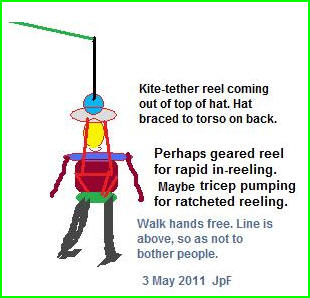 Hat-pole Kiting.
When, where, why, how, video, specification, experience, safety.
People, wires, gusts. Parade... group of paraders with there
hat-poled kite systems. HTA kites. LTA kytoons. Hat-pole Kiting.
When, where, why, how, video, specification, experience, safety.
People, wires, gusts. Parade... group of paraders with there
hat-poled kite systems. HTA kites. LTA kytoons.
|
- Sky Windpower - Power
Generation Flight - Angle 2
video 2:01 Using pole in testing...
Published on May
9, 2012
Our Jabiru II prototype is shown in December 2011 tests in free flight
under the aft safety tether at approximately 2.5 lbs. tension. A power
supply transmits power through the tether to Jabiru II, enabling it to
rise to altitude in horizontal flight. When the tow vehicle's ground
speed causes enough "wind," the craft "noses" up into power generation
attitude, stops drawing power from the supply and starts generating
electricity, which is transmitted through the taut forward tether to
the load bank. The Flying Electric Generator (FEG) continues
generating electricity until the wind speed decreases to a level not
supportive of generation. The FEG then returns to horizontal flight
and resumes drawing from the power supply. The FEG prototype then
lands on the trailer bed after the tow vehicle has stopped.
|
Types of Pole Kiting
- Hand-held stick with a sting tethering wings of various
configurations
-
Kite Boat Gna circa 1909
- Tipping Boom AWES
- KiteGen Stem AWES
- WPI Rocker Arm AWES
- SkySails Launcher Pole Traction AWES
- Hat-Based Pole Kiting
- Strategic Use of Ambient Urban Poles
- Hand-held Pole Kiting Without Rotation
- Hand-held Pole Kiting With Rotation
- Powered Rotating Beam-Based Kiting
- Fishing Rod Kiting
- Two-Pole-Held Limit Cable Kiting
- Two-Poled Cable As Base of Main Tethers
- Fence Posts Gang Kiting
- Flagpole Flag Flying
-
Single-Stake Pilot Station
- Ancient Boat-Held Pole Leaf-Wing Kite Fishing
- Two Poles, One as tether anchor, the other as fairlead for the
tether; pilot walks as a second fairlead between the poles catching the
tether. Walking so as to multiply tether gather gives the wing twice the
ground speed as the walk. Depending on which side the tether starts on
the fairlead pole, the pilot may walk windward or downwind to gather.
- Three poles: Anchor tether to left pole and lead tether behind
middle and right pole; pulley grasp the tether at the two mid-pole
spaces. Pilot walks the two pulleys allowing line to move freely, and
the walk forms four strands of the tether to multiply the tether-gather
speed four times.
|
|
Windless pole kiting indoors
|
|
|
|
|
|
|
|
|
|
A
B
C
D
E
F
G
H
I
J
K
L
M
N
O
P
Q
R
S
T
U
V
W
X
Y
Z
Let us know you and your interests.
News, notes, documents, files:
Editor@UpperWindpower.com
~~ Kite Energy Community ~~
~ AWES Museum
~ |
 Hat-pole Kiting.
When, where, why, how, video, specification, experience, safety.
People, wires, gusts. Parade... group of paraders with there
hat-poled kite systems. HTA kites. LTA kytoons.
Hat-pole Kiting.
When, where, why, how, video, specification, experience, safety.
People, wires, gusts. Parade... group of paraders with there
hat-poled kite systems. HTA kites. LTA kytoons.

